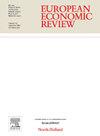文化亲近和公司间贸易
IF 2.4
2区 经济学
Q1 ECONOMICS
引用次数: 0
摘要
低质量的制度在新兴经济体中普遍存在,产生了微观层面的贸易摩擦。因此,企业可以依靠非正式制度和企业所有者之间的社会文化联系来克服这种摩擦。利用新的印度企业间贸易微观数据,包括价格、交易、种姓和宗教联系等信息,我们发现,较高的种姓和宗教接近度降低了价格,促进了贸易的集约化和外延化。我们提供支持性证据,证明这种接近性减轻了收缩摩擦。我们将这些发现形式化在企业所有者之间具有文化接近性的定量企业间贸易模型中。一项政策反事实分析表明,由文化距离较近的企业组成的经济体比文化距离较远的企业组成的经济体具有更低的成本、更低的价格、更高的销售额和更高的福利。本文章由计算机程序翻译,如有差异,请以英文原文为准。
Cultural proximity and inter-firm trade
Low-quality institutions are prevalent in emerging economies, generating micro-level trade frictions. Consequently, firms may rely on informal institutions and socio-cultural ties between firm owners, to overcome such frictions. Using new microdata on firm-to-firm trade from India with information on prices, transactions, and caste and religious connections, we find that higher caste and religious proximity reduces prices, and fosters trade at intensive and extensive margins. We provide supporting evidence on such proximity alleviating contracting frictions. We formalize these findings in a quantitative inter-firm trade model with cultural proximity between firm owners. A policy counterfactual analysis indicates that an economy composed of culturally closer firms features lower costs, lower prices, higher sales, and higher welfare than an economy with culturally distant firms.
求助全文
通过发布文献求助,成功后即可免费获取论文全文。
去求助
来源期刊

European Economic Review
ECONOMICS-
CiteScore
4.70
自引率
3.60%
发文量
170
期刊介绍:
The European Economic Review (EER) started publishing in 1969 as the first research journal specifically aiming to contribute to the development and application of economics as a science in Europe. As a broad-based professional and international journal, the EER welcomes submissions of applied and theoretical research papers in all fields of economics. The aim of the EER is to contribute to the development of the science of economics and its applications, as well as to improve communication between academic researchers, teachers and policy makers across the European continent and beyond.
 求助内容:
求助内容: 应助结果提醒方式:
应助结果提醒方式:


